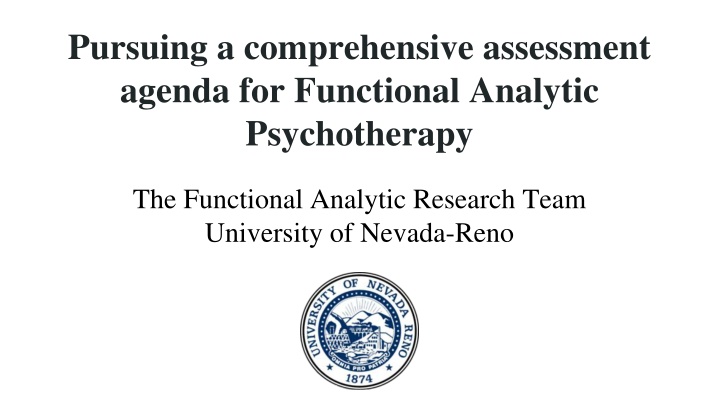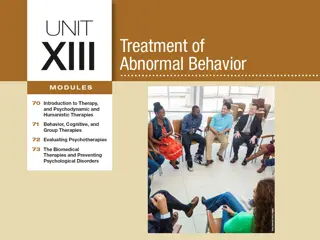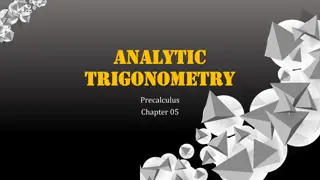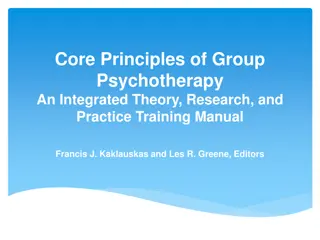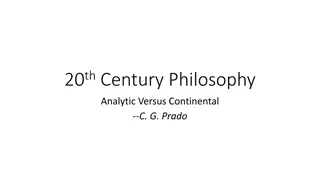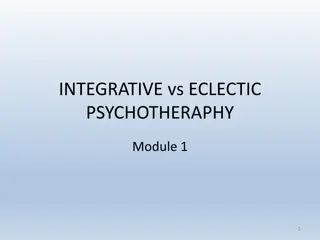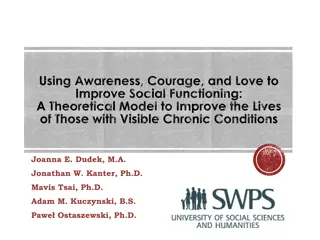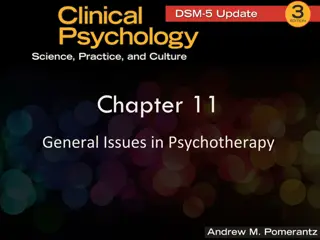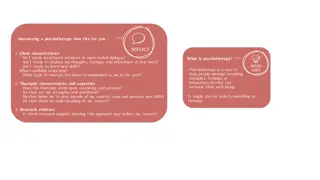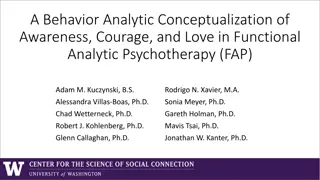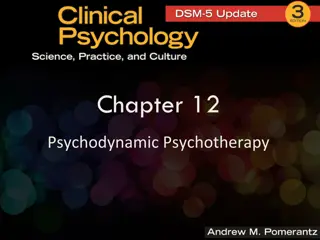Comprehensive Assessment Agenda for Functional Analytic Psychotherapy
Pursuing a comprehensive assessment agenda in Functional Analytic Psychotherapy involves psychometric measurement of interactions in and out of session. The research team at the University of Nevada-Reno discusses the goals, challenges, and tools essential for behavior therapists and researchers, aiming to maximize reinforcement and minimize aversive control. Current considerations include expanding assessment procedures to enhance therapy outcomes.
Download Presentation

Please find below an Image/Link to download the presentation.
The content on the website is provided AS IS for your information and personal use only. It may not be sold, licensed, or shared on other websites without obtaining consent from the author.If you encounter any issues during the download, it is possible that the publisher has removed the file from their server.
You are allowed to download the files provided on this website for personal or commercial use, subject to the condition that they are used lawfully. All files are the property of their respective owners.
The content on the website is provided AS IS for your information and personal use only. It may not be sold, licensed, or shared on other websites without obtaining consent from the author.
E N D
Presentation Transcript
Pursuing a comprehensive assessment agenda for Functional Analytic Psychotherapy The Functional Analytic Research Team University of Nevada-Reno
Psychometric measurement of interactions in- and out-of- session Timothy Feeney, M.A. Cory Stanton, M.S.* William Follette, Ph.D. University of Nevada-Reno *presenting author
Need CE credit for this session? Please don t forget to scan in to have your attendance tracked!
Disclosure Statement Timothy Feeney, Cory Stanton, & William Follette We have not received and will not receive any commercial support related to this presentation or the work presented in this presentation
Goals Understand the context we work in as behavior therapists and researchers Discuss tools that may be useful to our analytic goals
The problem (Follette & Hauts, 1996) DSM focused on reliability, but placed validity on the back burner The goal of a medical model is to describe the etiology, treatment, and course of a diagnostic category; therefore, it s a binary outcome of disorder vs. no disorder
The problem As contextualists and behaviorally inclined folks, that can be problematic for us General goal: maximize the amount of reinforcement people have available to them, and minimize the amount of apparent aversive control Values (Bonow & Follette, 2009)
The problem One goal in treatment is to get folks to interact with their environment successfully Interpersonal success in all of its forms
Current considerations in our lab Expanding the repertoire of assessment procedures to find out what real behavioral features are useful in accomplishing therapy goals The functions of one s social reinforcement repertoire
The importance of interpersonal functioning Many behavioral health presentations have a social component Access to social support is important for adolescent and adult mental health (Seeman, 1996; Taylor, 2011) The dyad is a common unit of analysis (Laursen, 2005) Research Clinical
The challenge of measuring it well Being embedded in the analytic unit Client and therapist histories
Functional Analytic Psychotherapy (Kohlenberg & Tsai, 1991) A radical behavioral approach to psychotherapy focused on contingent responding in the context of an intimate therapeutic relationship FAP researchers and clinicians are naturally oriented towards considering these issues
So what do we want from instruments? Reliability & Validity Treatment Utility (Hayes, Nelson, & Jarrett, 1987)
What have we tried in FAP so far? FAP Session Bridging Form (Tsai et al., 2009) FAPRS (Callaghan & Follette, 2008) FIAT-Q (Callaghan, 2006) and FIAT-Q-SF (Darrow, Callaghan, Bonow & Follette, 2009) FAP-IS (Leonard et al., 2014) FAP Impact Scale (Kanter, Tsai, Holman, & Koerner, 2013)
Impact Message Inventory (IMI: Perkins, Kiesler, Anchin, Chirico, Kyle, & Federman, 1979; IMI-C: Schmidt, Wagner, & Kiesler, 1999) Measures the covert reaction of the listener to the speaker s behavior
Social Relations Survey (SRS; Lorr, Youniss, & Stefic, 1991) 128 true / false items Domains: social assertiveness, defense of rights, positive feeling, directiveness, approval need, confidence, perceived approval, & empathy
Interpersonal Competence Questionnaire (ICQ; Buhrmester, Furman, Wittenberg, & Reis, 1988) 40 item self-report Domains: initiating relationships, disclosing personal information, asserting displeasure with others, providing emotional support, & managing interpersonal conflict
Some suggestions for clinicians Try out the excellent tools that are out there Understand your own assumptions and the theoretical basis you re working from
Some suggestions for researchers Pursue research consistent with CBS principles Develop tight, functional definitions of our constructs of interest Maintain a commitment to diverse designs and measurements
Thank You! tkfeeney1@gmail.com - corystanton@nevada.unr.edu - follette@unr.edu Up next: Bill will discuss the complexities of functional assessment for therapists
References (in order of citation) Follette, W. C., & Houts, A. C. (1996). Models of scientific progress and the role of theory in taxonomy development: A case study of the DSM..Journal of Consulting and Clinical Psychology,64(6), 1120-1132. Bonow, J. T., & Follette, W. C. (2009). Beyond values clarification: Addressing client values in clinical behavior analysis. The Behavior Analyst,32(1), 69-84. Goldiamond, I. (1974). Toward a constructional approach to social problems: ethical and constitutional issues raised by applied behavior analysis. Behaviorism,2(1), 1-84. Seeman, T. E. (1996). Social ties and health: The benefits of social integration. Annals of epidemiology,6(5), 442-451. Taylor, S. E. (2011). Social support: A review.The handbook of health psychology, 189-214. Laursen, B. (2005). Dyadic and group perspectives on close relationships.International Journal of Behavioral Development,29(2), 97-100. Kohlenberg, R.J., & Tsai, M. (1991). Functional Analytic Psychotherapy: Creating intense and curative therapeutic relationships. New York, NY: Springer. Hayes, S. C., Nelson, R. O., & Jarrett, R. B. (1987). The treatment utility of assessment: A functional approach to evaluating assessment quality. American Psychologist,42(11), 963-974. Tsai, M., Kohlenberg, R. J., Kanter, J. W., Kohlenberg, B., Follette, W. C., & Callaghan, G. M. (2009). A guide to functional analytic psychotherapy: Awareness, courage, love and behaviorism. New York, NY: Springer.
References (in order of citation) Callaghan, G. M., Follette, W. C., Ruckstuhl Jr, L. E., & Linnerooth, P. J. (2008). The Functional Analytic Psychotherapy Rating Scale (FAPRS): A Behavioral Psychotherapy Coding System.The Behavior Analyst Today,9(1), 98.-116. Callaghan, G. M. (2006). The Functional Idiographic Assessment Template (FIAT) system: For use with interpersonally-based interventions including Functional Analytic Psychotherapy (FAP) and FAP-enhanced treatments.The Behavior Analyst Today,7(3), 357-398. Darrow, S. M., Callaghan, G. M., Bonow, J. T., & Follette, W. C. (2014). The Functional Idiographic Assessment Template-Questionnaire (FIAT- Q): Initial psychometric properties.Journal of Contextual Behavioral Science,3(2), 124-135. Leonard, R. C., Knott, L. E., Lee, E. B., Singh, S., Smith, A. H., Kanter, J., ... & Wetterneck, C. T. (2014). The development of the functional analytic psychotherapy intimacy scale.The Psychological Record,64(4), 647-657. Kanter, J. W., Tsai, M., Holman, G., & Koerner, K. (2013). Preliminary data from a randomized pilot study of web-based functional analytic psychotherapy therapist training.Psychotherapy,50(2), 248-257. Perkins, M. J., Kiesler, D. J., Anchin, J. C., Chirico, B. M., Kyle, E. M., & Federman, E. J. (1979). The Impact Message Inventory: A new measure of relationship in counseling/psychotherapy and other dyads.Journal of Counseling Psychology,26(4), 363-367. Schmidt, J.A., Wagner, C.C., & Kiesler, D.J. (1999). Psychometric and circumplex properties of the Octant Scale Impact Message Inventory (IMI-C): A structural evaluation. Journal of Counseling Psychology, 46(3), 325-334. Lorr, M., Youniss, R.P., & Stefic, E.C. (1991). An inventory of social skills. Journal of Personality Assessment, 57(3), 506-520. Buhrmester, D., Furman, W., Wittenberg, M. T., & Reis, H. T. (1988). Five domains of interpersonal competence in peer relationships. Journal of Personality and Social Psychology, 55(6), 991-1008
